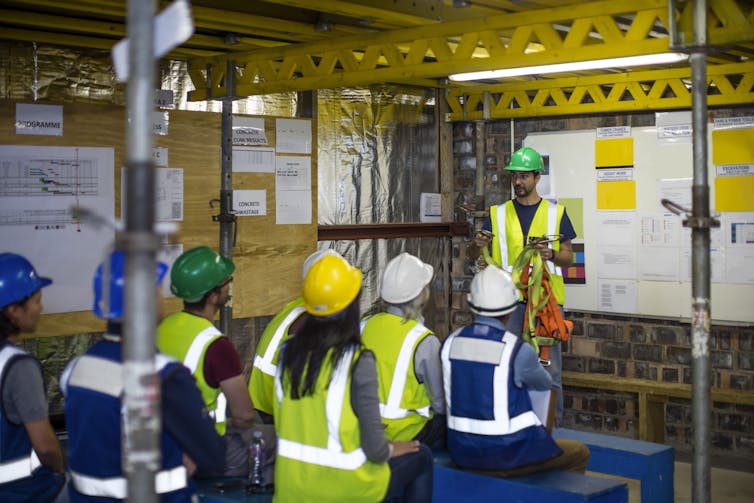
U.S. employees are increasingly struggling with mental health challenges tied to their jobs, such as depression, anxiety and burnout.
We’re professors who research how employees interact and workplace well-being. After noticing that research on mental health and work had not kept up with the increasing prevalence of mental health challenges, we reviewed existing findings on mental health and work to see how scholars can best investigate these issues going forward.
We found that employers could greatly reduce the causes of many of their employees’ mental health challenges through basic human resources approaches, such as taking tasks away from someone who is perpetually swamped or providing more job flexibility. But those fixes, as we explained in the journal Academy of Management Annals, would require work-related changes employers rarely make or authorize.
We analyzed the findings from 556 articles by researchers on this topic and observed that helping individual employees cope after their problems emerge is far more common than taking steps to preemptively fix problems that are contributing to workers’ conditions.
Culture and job design
When you think about jobs that can take a toll on mental health, some very demanding and stressful professions may come to mind. Doctors, nurses, soldiers and first responders, for example, often do suffer due to their regular contact with illness and death on the job.
Yet, we found that the tasks employees perform are often not what leads to their mental health degradation. Instead, an employer’s culture and the way its jobs are designed play big roles.
This pattern can explain why poor mental health manifests in all lines of work, not just emotionally demanding jobs. The Centers for Disease Control and Prevention has found, for instance, that suicide rates for farmworkers, truckers and warehouse workers are among the nation’s highest.
An employer’s culture lays the groundwork for the quality of social interactions among its employees – and, depending on the profession, with clients, students or the public.
The way people deal with one another can prove important. For instance, employees who endure workplace bullying and don’t have a supportive boss or colleagues that they can talk to are more likely to have poor mental health.
The way that a job is designed can cause stress, anxiety and feelings of mental and emotional exhaustion. Not having the authority to make decisions, lacking clarity about responsibilities and facing obligations that regularly conflict with personal obligations, infringing upon personal and family time, can all increase the risk of mental health problems.
Workplace culture and job design also matter for people doing inherently traumatic jobs.
A review of 61 studies of humanitarian aid workers’ mental health made clear that poor leadership and insufficient support for workers caused disproportionate damage to their mental health. These factors were separate from the trauma they regularly witnessed and experienced in the aftermath of disasters.
This body of research indicates that all employers can reduce work-related mental health risks by scrutinizing how jobs are designed and determining whether any positions should be reconfigured for the sake of their employees’ mental health.
Mental health benefits
Employers have a choice. They can take steps to prevent mental health damage before it occurs, or they can deal with its aftermath. Both are important, but according to the body of research we’ve reviewed, the latter is far more common.
People with chronic mental illnesses can thrive at work in the right conditions. And most U.S. employers today do provide access to mental health benefits, partly due to the Affordable Care Act. The ACA, which Congress passed in 2010, requires insurance companies to treat mental health care the same way they treat physical health care when offering coverage.
About 78% of U.S. employers provide mental health benefits, including employee assistance programs, and work benefits that provide individual mental health, financial and legal support. Such measures are useful, but only after the harm has taken place. These benefits generally do nothing about psychological hazards tied to work and preventing work-related harm.
Further, many employees who need help don’t take advantage of these programs.
4 steps to reduce the toll work takes on mental health
Here are four steps employers can take to address the causes of poor mental health:
Revise job descriptions. Employers should eliminate ambiguity, wherever that’s possible, about core duties and responsibilities. They should communicate with employees to ensure they understand why their jobs might require flexibility and adaptation. In times when workloads get unavoidably large, such as what happens at accounting firms in the weeks before Tax Day, employers should strive to balance long shifts with opportunities for employees to rest and recharge.
Proactively train staff on the positive behaviors expected of them. Just as employers strategically plan which job-related skills are important, they can also strategically identify what interpersonal skills are important and value these like technical capabilities with hiring and promotions. If employees engage in bullying behavior, employers can retrain, reassign or fire them accordingly.
Help employees build resilience. Research on police officers suggests that when they get resilience-building training before experiencing trauma on the job, it can reduce the risk of developing post-traumatic stress disorder. Similar types of resilience training could also help in less inherently traumatic lines of work.
Don’t assume that employees will speak up. Only 65% of employees with mental health challenges say that they would tell a co-worker, manager or human resources representative about those problems. They may conceal the severity of these issues even if they do talk about them, due to the stigma associated with mental health problems. Proactively addressing the causes of poor mental health for everyone is key, because there’s no way for employers to know the extent of these problems.

Spotting hazards
Spotting physical hazards on the job is easier than identifying psychological hazards. Yet that doesn’t mean the psychological hazards are less dangerous or can’t be addressed.
Requiring hard hats, posting warnings and mandating safe work habits have reduced accidents in factories, on construction sites and at other workplaces. Likewise, researchers have found that redesigning jobs and adopting better workplace cultures can go a long way toward improving mental health.
Jaclyn Koopmann previously worked on research funded by a grant from the National Institute on Alcohol Abuse and Alcoholism.
Emily Rosado-Solomon and Matthew A. Cronin do not work for, consult, own shares in or receive funding from any company or organization that would benefit from this article, and have disclosed no relevant affiliations beyond their academic appointment.
This article was originally published on The Conversation. Read the original article.







